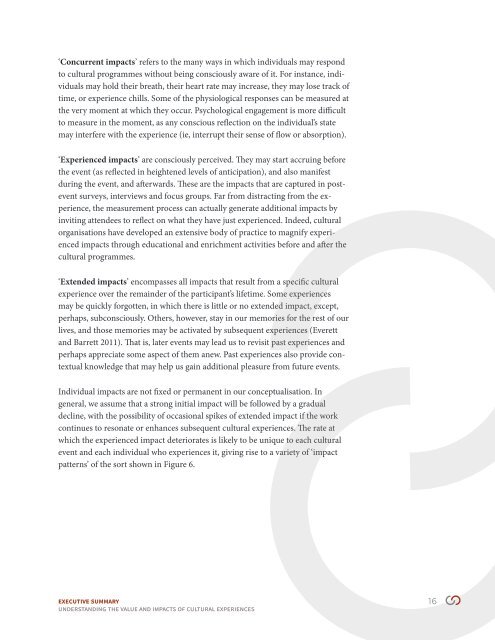aceUVi
aceUVi
aceUVi
Create successful ePaper yourself
Turn your PDF publications into a flip-book with our unique Google optimized e-Paper software.
‘Concurrent impacts’ refers to the many ways in which individuals may respond<br />
to cultural programmes without being consciously aware of it. For instance, individuals<br />
may hold their breath, their heart rate may increase, they may lose track of<br />
time, or experience chills. Some of the physiological responses can be measured at<br />
the very moment at which they occur. Psychological engagement is more difficult<br />
to measure in the moment, as any conscious reflection on the individual’s state<br />
may interfere with the experience (ie, interrupt their sense of flow or absorption).<br />
‘Experienced impacts’ are consciously perceived. They may start accruing before<br />
the event (as reflected in heightened levels of anticipation), and also manifest<br />
during the event, and afterwards. These are the impacts that are captured in postevent<br />
surveys, interviews and focus groups. Far from distracting from the experience,<br />
the measurement process can actually generate additional impacts by<br />
inviting attendees to reflect on what they have just experienced. Indeed, cultural<br />
organisations have developed an extensive body of practice to magnify experienced<br />
impacts through educational and enrichment activities before and after the<br />
cultural programmes.<br />
‘Extended impacts’ encompasses all impacts that result from a specific cultural<br />
experience over the remainder of the participant’s lifetime. Some experiences<br />
may be quickly forgotten, in which there is little or no extended impact, except,<br />
perhaps, subconsciously. Others, however, stay in our memories for the rest of our<br />
lives, and those memories may be activated by subsequent experiences (Everett<br />
and Barrett 2011). That is, later events may lead us to revisit past experiences and<br />
perhaps appreciate some aspect of them anew. Past experiences also provide contextual<br />
knowledge that may help us gain additional pleasure from future events.<br />
Individual impacts are not fixed or permanent in our conceptualisation. In<br />
general, we assume that a strong initial impact will be followed by a gradual<br />
decline, with the possibility of occasional spikes of extended impact if the work<br />
continues to resonate or enhances subsequent cultural experiences. The rate at<br />
which the experienced impact deteriorates is likely to be unique to each cultural<br />
event and each individual who experiences it, giving rise to a variety of ‘impact<br />
patterns’ of the sort shown in Figure 6.<br />
Executive Summary 16<br />
UNDERSTANDING the value and impacts of cultural experiences


